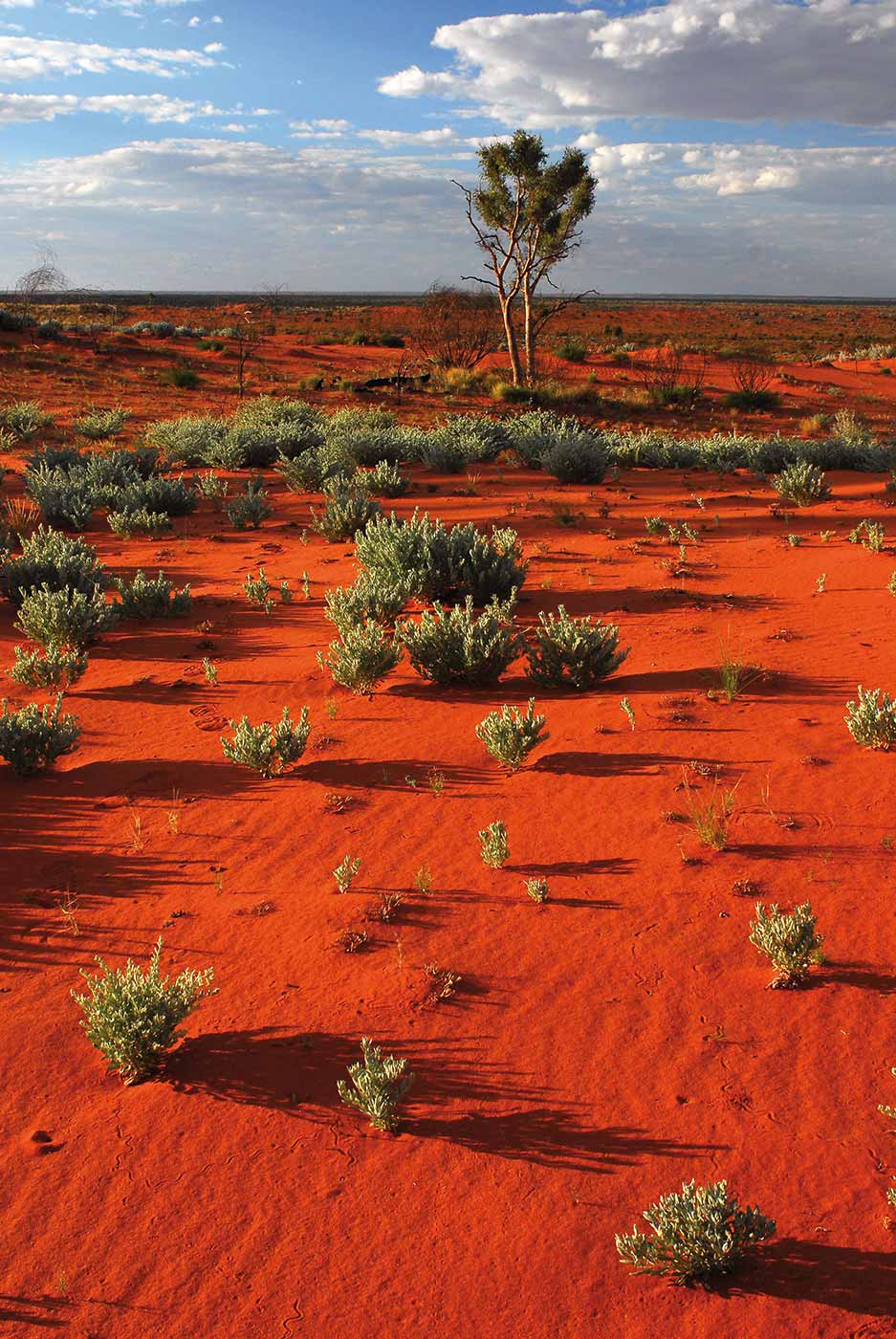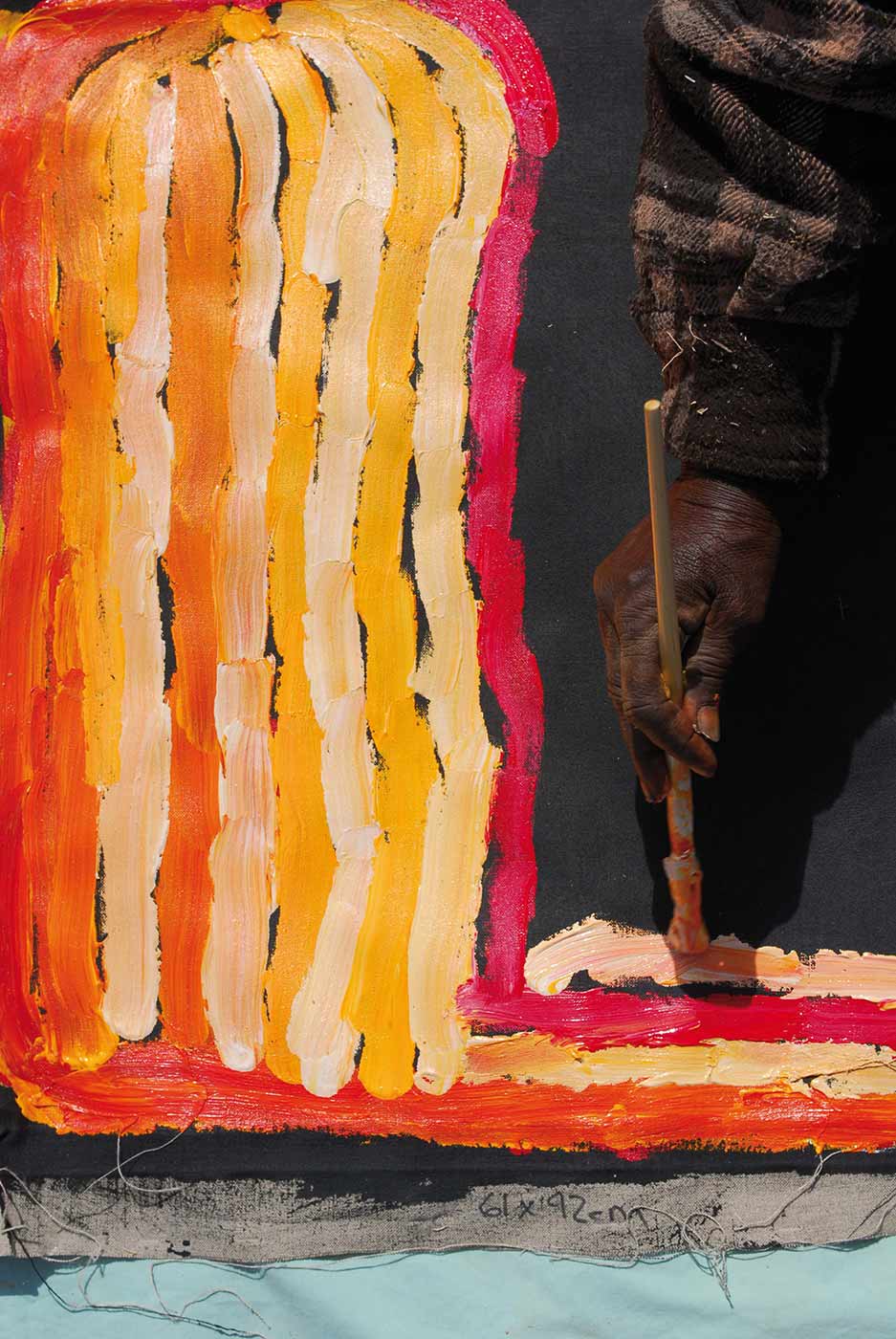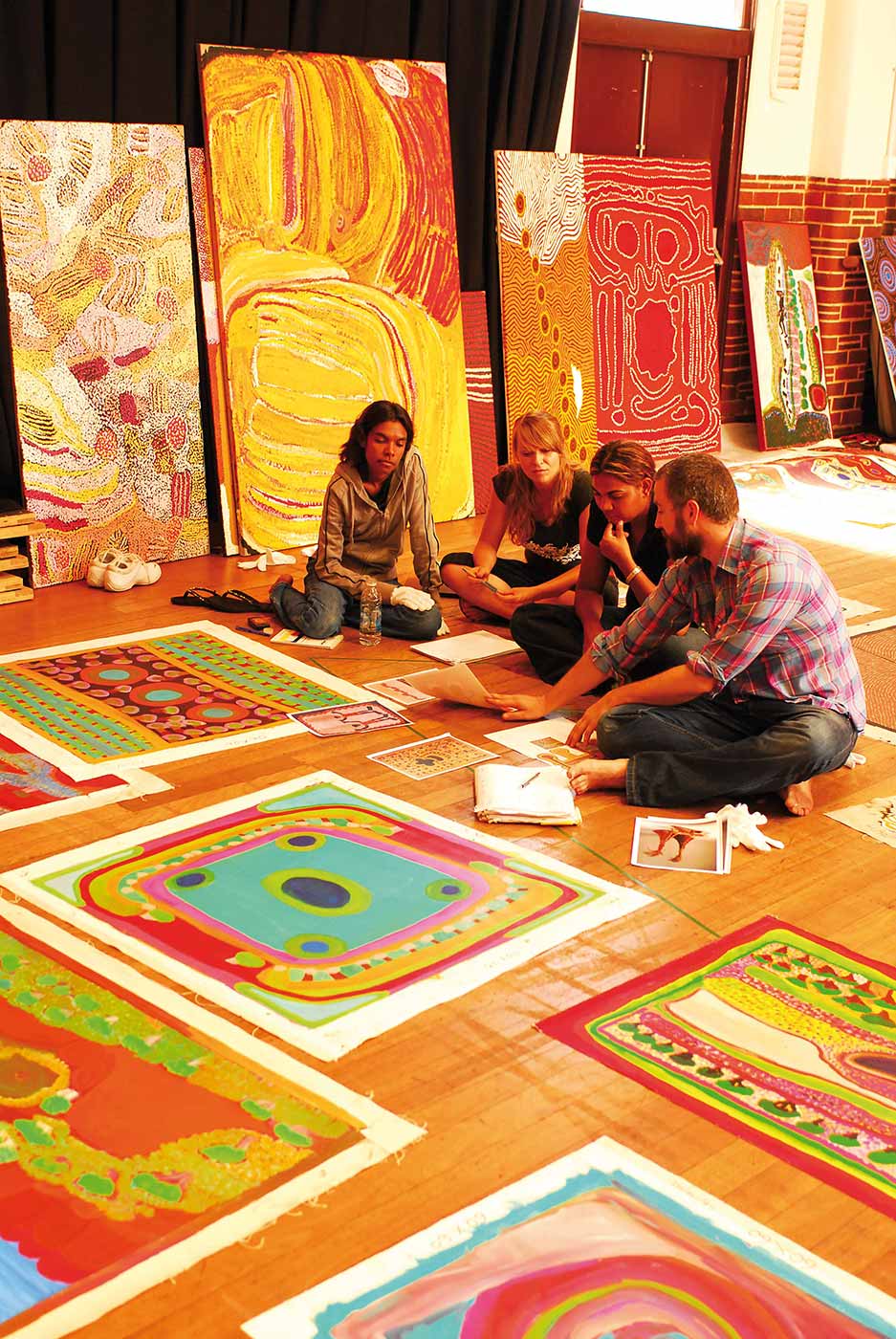
The communities, the National Museum of Australia and FORM all worked together to create this special exhibition, Yiwarra Kuju: The Canning Stock Route.
From the communities
Putuparri Tom Lawford, Fitzroy Crossing, 2007:
Listening to the old people's story from the past. Good ones, sad ones. Now it's up to us to tell them to our future generations.
We hope kartiya (non-Aboriginal people) learn the history of the Canning Stock Route from the paintings and stories of Aboriginal people, and come to understand what the history is really about.
It used to be blackfella Country before they built the wells. Today it's a kartiya highway. Before it used to be Aboriginal people's land, our Jukurrpa (Dreaming), waterholes, jumu (soakwaters) and jila (springs).
Blackfellas used to walk around – foot-walk – not with a camel. When they saw camels and horses they'd get frightened and run away. Martu people got shot in that Country, and at Kulyayi (Well 42) Wangkajunga people got killed.
Canning made a mess of the wells and Dreaming tracks and sacred sites and law sites. He used blackfellas to get where he wanted to go, to make his mark. So it's about kartiya coming and making that line of wells.
But in another way, all those wells opened up our Country for people to travel back to Country with their kids. Because if you didn't do that the Country would be lost. Now it's easier to get to Country. We've got our own story there, two ways.
We're all family. All the stories are about how all the families got scattered across the Western Desert. And at the nine art centres, we're all related. From Wiluna and Kiwirrkurra and Balgo, Mulan, and Martu Country. From Nyarna (Lake Stretch) right down to Wiluna. Our ancestors walked that land.
The Canning Stock Route forced all the people to all different places. But people still talk about their Country and call the names, and we talk about how all the art centres are going to tell their stories. Everybody has that same story.
Some stories can be told, some stories can't be told, from the Dreamtime. There are too many stories. All these stories, all told by our old people.
Ngarralja Tommy May
Mangkaja artist and senior cultural adviser
Putuparri Tom Lawford
Senior translator and cultural adviser
Murungkurr Terry Murray
Co-curator. Fitzroy Crossing, March, 2010
From the Museum

The National Museum of Australia is justifiably proud of its collections: not for their sheer mass alone, but rather for the quality of the objects, the power of their inherent meanings and their supporting histories.
Many collections evolve slowly; some collections are special right from the start. The Canning Stock Route collection, which the Museum acquired in March 2008, is one such collection.
It arose out of the Canning Stock Route Project initiated by FORM, an independent arts organisation based in Perth, Western Australia, in 2006.
This project involved several years of intensive research by the FORM team in equal collaboration with Aboriginal artists and their respective art centres and organisations.
The Canning Stock Route is a place where Indigenous and non-Indigenous histories intersect. First surveyed by Alfred Canning in 1906, it is the longest historic stock route in the world, running almost 2000 kilometres across Western Australia, from Halls Creek to Wiluna.
The development of this ultimately unsuccessful venture dramatically affected the lives of the Aboriginal people who lived in the region traversed by the stock route.
For many years the story of the stock route was told as a white man's story. Yet viewing the works in this collection makes us recognise that this story goes back much further and is held firmly in the hearts and minds of the Aboriginal people who lived there.
The Canning Stock Route Project has recovered the Indigenous history of this region.
During a six-week trip along the Canning Stock Route in 2007 and subsequent community workshops and bush trips, 80 artists created a collection of paintings, contemporary cultural objects and documentary material, from which the 127 works in the final collection were curated.
This unique collection has emerged through a strategic research process founded on ethical consultation. As a result, the various works and objects are accompanied by rich documentation – papers, interviews, photographs and film.
Particularly significant is the emphasis that has been given to Aboriginal voices – the words of the artists themselves – in documenting the collection and in developing the philosophies that will guide its future management.
Acquisition of the collection also represented another significant first for the National Museum of Australia. While many museums develop exhibitions under sponsorship from external agencies, the day-to-day relationship between sponsor and museum is usually somewhat independent.
The relationship between FORM and the National Museum of Australia is different; it represents a close collaboration, one in which the research done by the FORM team has come together with the resources of the Museum.
I commend my predecessor, Craddock Morton, whose decisions to acquire the collection and establish a partnership with FORM to develop an exhibition were ambitious and far-sighted. The Canning Stock Route collection, has already become a great resource and will continue to be one for the future.
Andrew Sayers
Director, National Museum of Australia
From FORM

Since late 2006 FORM has had the privilege of working closely with some of Western Australia's finest Aboriginal artists and their Countrymen, to build the celebrated Canning Stock Route Project.
Set in the striking desert landscapes of the Kimberley, Pilbara, Western Desert regions and the goldfields, this project aimed to create economic and professional development opportunities for the remote communities situated near the stock route.
But in the process the project also became part of the life of the communities that embraced it.
For it is the voices of the artists and their families that emerge so clearly in both the Yiwarru Kuju exhibition and the catalogue; their knowledge and their culture highlight the importance of family connection and kinship and of their intimate relationship with the land.
Equally important for the successful delivery of a project of this scale have been the partnerships that embraced the original vision and made possible the essential funding, without which the project could not have been realised.
The first and most enduring of our partners has been BHP Billiton Iron Ore. They were with us from the very beginning, and the spin-off benefits in terms of cultural awareness and community capacity-building have been far-reaching, extending well beyond their original commitment.
The other major partners have been the Indigenous Land Corporation and the Government of Western Australia Department of Culture and the Arts.
The relationship with the remote communities who collaborated with FORM on the Canning Stock Route Project has matured over the course of the past four years. It has been nurtured by the leadership of Carly Davenport, Monique La Fontaine, John Carty, Nicole Ma, Putuparri Tom Lawford, Ngalangka Nola Taylor and Tim Acker, and been informed by the highly skilled team of professionals who worked with them to realise the full potential of the project.
In particular, FORM would like to thank the National Museum of Australia for its leadership; the purchase of the collection by the Museum fulfilled one of the dreams of the Aboriginal contributors.
The content developed in partnership with the remote communities, under the guidance of emerging Aboriginal curators and media specialists, now rests in safe hands for the benefit of future Australians.
The emerging curatorial and media team has been mentored throughout the project through a structured program of development.
Co-curators Hayley Atkins, Doolmarria Louise Mengil and Murungkurr Terry Murray, and media practitioners Clint Dixon, Morika Biljabu, KJ Kenneth Martin and Curtis Taylor have been integral to the shaping of the exhibition and to our understanding of the people and their relationship to the land surrounding the Canning Stock Route.
All seven members of this team are very familiar with the concept of mentoring, which has been a common thread in their upbringing through the efforts of their families.
We have been privileged to have worked on this project and to have known the many special people who have shared their collective knowledge with us and with the broader Australian community.
Lynda Dorrington
Executive Director, FORM